Multicore
RM92 solder creams have been formulated as No Clean RMA
type products showing superior resistance to preheat
slump during reflow processes.
- Screen printing and
stenciling grades
- Grades suitable for
fine pitch applications available
- Excellent
resistance to preheat slump
- Good tack
performance and wetting
- Residues may be
left uncleaned
PRODUCT
RANGE
Multicore
RM92 solder creams may be supplied with powder made from
most solder alloys in the Multicore Product Range. The
most common alloys used are Sn60, Sn62 and Sn63
conforming to the purity requirements of J-STD-006 and
EN 29453. Minimum order requirements may apply to
certain alloys and powder particle sizes.
A wide range of metal contents and solder
powder particle size distributions may be ordered but
most applications will be served by the following
recommended products:
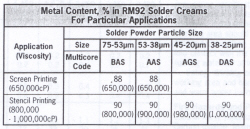
For dispensing applications, the equivalent Multicore
RM89 solder creams are recommended.
If clear residues are preferred, the user
should evaluate the Multiprint range. Customers wishing
to print at high speed should consider Multicore RP10
solder creams.
RECOMMENDED
OPERATING CONDITIONS
APPLICATION:
The appropriate grades of Multicore RM92 solder creams
have been specially formulated for application by screen
printing and stenciling. They do not require the
addition of thinners either before use. It is
recommended that products shipped in jars should be
gently stirred for 15 seconds before use.
REFLOW:
Any of the available methods of heating to cause reflow
may be used including IR, convection, hot belt, vapour
phase and laser soldering. It is not practicable to
recommend an ideal reflow temperature profile for all
situations. However, the following shows an example
profile which has given good results in practice.
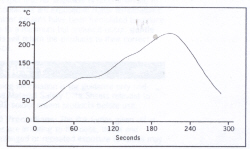
Multicore RM92 solder creams have been
specially formulated to show a marked resistance to
preheat slump. They can tolerate the longer
preheat times often required for large surface
mounted devices or densely populated boards.
Furthermore, Multicore RM92 solder creams are less
liable to char during reflow at the elevated
temperatures required for some solder alloys.
CLEANING:
The residues from
Multicore RM92 solder creams may be left on the PCB in
many applications since they do not pose a hazard to
long term reliability. However, should there be a
specific requirement for residual removal, this may be
achieved using conventional cleaning processes based on
solvents such as Multicore Prozone, or water containing
suitable saponifying agents such as Multicore PC85.
TECHNICAL
SPECIFICATIONS
SOLDER
POWDER: The
solder powder for Multicore RM92 solder creams is
produced by atomising alloys conforming to the purity
requirements of J-STD-006, EN 29453 or other national
and international standards where relevant.
Careful control of production processes ensures that the
solder powder is at least 97% spherical (aspect ratio
< 1.5) and contains less than the minimum level of
contaminants that would adversely affect solder cream
performance. A typical maximum oxide contamination level
of 80ppm (expressed as oxygen in the solder) is
regularly achieved or bettered.
SOLDER
CREAM MEDIUM: The flux for Multicore RM92 solder
creams is a RMA type showing the following
characteristics. Test reports are available on request.
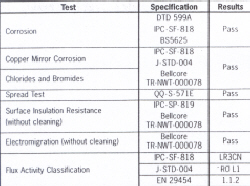
|
|
SOLDER
CREAM: The properties of a solder cream depend in
part on the metal content, the solder alloy and the
solder powder particle size range. In general terms,
increasing metal content reduces the tendency to slump
and reduces the tackiness of the solder cream while the
solder balling performance improves. Using solder alloys
with increased density has the same effect as reducing
the metal content.
It is common practice to characterise the
rheology of solder creams by making a viscosity
measurement at a single specified shear condition.
Increasing metal content increases the measured value
and at higher metal contents, decreasing the mean solder
powder particle size can have the same effect.
The characteristics of Multicore RM92
solder creams which confer their superior slump
performance also increase their sensitivity to the
conditions of sample preparation before making
Brookfield viscosity determinations. Excessive stirring
before testing can lead to erroneously low values for
viscosity. A more informative indication of the
rheological properties of solder creams is provided by a
plot of viscosity versus shear rate and these typical
results for a selected Multicore RM92 solder cream are
shown in the following graph.
Typical properties of selected Multicore
RM92 solder creams are as follows. Full details of test
methods will be supplied on request.
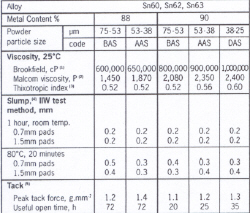
VISCOSITY
DATA FOR SELECTED MULTICORE Sn62RM92 SOLDERING CREAMS
Measurements made with the Malcolm Viscometer
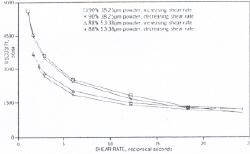
PACKAGING
CONTAINERS:
Multicore RM92 solder
creams are supplied in:
-
1kg,
500g or 250g plastic jars with an insert to seal off
the surface of the cream
-
1kg
vacuum filled cartridges for direct application
Other
forms of packaging may be available on request.
SHELF
LIFE: Providing
Multicore RM92 solder creams are stored at 5 - 10°C
tightly sealed in the original container, a minimum
shelf life of 12 months can be expected.
Multicore RM92 solder creams have been
formulated to reduce separation on storage to a minimum
but should it occur, gentle stirring for 15
seconds will return the products to their correct
rheological performance.
HEALTH
& SAFETY
WARNING:
The following information
is for guidance only and users must refer to the
Material Safety Data Sheets relevant to specific
Multicore RA10 solder cream products before use.
FUMES,
VAPOURS and PRECAUTIONS: The
flux fumes given off at soldering temperatures are
irritating to the nose, throat and respiratory organs.
Prolonged or repeated exposure to flux fumes may cause
sensitisation.
These materials should always be used in a
well ventilated area and suitable fume extraction
equipment should be used to extract flux fumes away from
the operators.
PROTECTION
& HYGIENE: Suitable
protective clothing should be worn to prevent materials
from coming into contact with the skin and eyes. If the
materials come into contact with the skin, the affected
area should be cleaned with a proprietary skin cleanser
followed by washing with soap and water. If the
materials come into contact with the eyes, they should
be irrigated thoroughly with running water for at least
ten minutes and medical attention sought.
Eating, drinking or smoking should not be
permitted in the working area and hands should be washed
thoroughly before eating.
FIRE
HAZARDS and PRECAUTIONS: The
flashpoint of the solvent used in these materials is
high (127°C) but it is combustible. Carbon dioxide,
foam or dry powder extinguishers are suitable. High
temperatures may produce heavy metal dust, fumes and/or
vapours. Do not use water where molten metal is present.
SPILLAGE
and WASTE DISPOSAL: Spills
of the materials should be scraped up and the
contaminated area washed with water.
Waste materials should be stored in closed
containers and disposed of in accordance with the
relevant local and national regulations.
|






